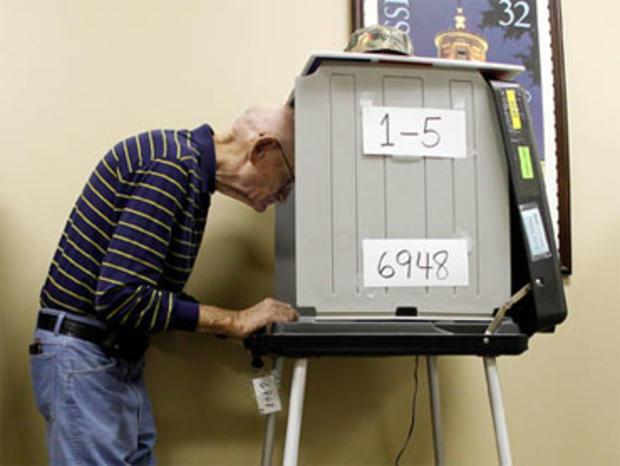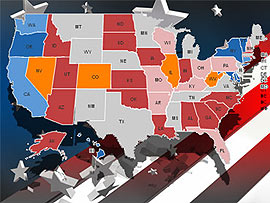With Two Weeks to Go, Senate and House Control Remain in Play
Well, the election has begun - absentees are available in almost all states now (Pennsylvania begins tomorrow). In-person early voting is now underway in 13 states, and in-person votes including absentees can be cast now in 30.
In 2008, one-third of the national total - 44 million ballots -- were cast before Election Day, either early or absentee, and there's no reason to think that percentage won't at least remain the same or increase in 2010. In recent years states have eased their restrictions on absentee voting, and many have also set up early voting centers where voters can cast ballots in person well in advance of Election Day.
It's important because early and absentee voting, of course, shorten the campaign season. It also increasingly puts a premium on campaign organizing. The two sides spend a great deal of effort to target their potential voters and assist them in voting early, not only so that they have a better sense of how they're doing at meeting their vote targets, but also to help make their Election Day Get-Out-The-Vote efforts (GOTV) more efficient at targeting the remainder of voters yet to vote.
And it's of high importance this year because a host of states with critical contests have a lot of early and absentee voting. Here is a sampling of the 2008 early/absentee vote in some of the states hosting critical contests for Senate this year - all of these have at least 1 in 5 ballots cast early, and many have about half cast early.
| State | '08 Percent Early/Absentee |
| Alaska | 30% |
| Arkansas | 44% |
| California | 45% |
| Colorado | 79% |
| Florida | 54% |
| Illinois | 22% |
| Indiana | 24% |
| Nevada | 67% |
| Ohio | 30% |
| Washington | 89% |
| West Virginia | 24% |
| Wisconsin | 21% |
The House:
House control is still up for grabs as Republicans appear poised to make gains - the question, of course, is whether they'll make enough to take control - and they've got many Democrats still tangled up in tossup races that will ultimately decide the fate of their majority.
Republicans need 39 net pickups to get control. They can get there with a combination of the seats in which they're favored, plus by getting some of the remaining tossups. There are a net 27 seats the Republicans are currently favored to gain as of now, plus there are 32 other tossup races in Democratic seats still remaining up for grabs. So if Republicans took 12 of those 32 tossups, adding that 12 to the 27 they're favored to net, they would get the 39 needed for control.
Critical Contests: Interactive Map with CBS News' Race Ratings
The Senate:
Control for Republicans remains doable but difficult; they'll look to make substantial gains of at least 2 to 5 seats, though, as Democrats in tossup states don't show signs of putting any breathing room between themselves and Republican challengers.
Wisconsin, a state President Obama won in 2008, is trending toward becoming one of those GOP pickups. Wisconsin, while comfortably blue in 2008, isn't often as solidly blue as that - it has seen its share of close elections in recent years (including the 2004 presidential race, decided by just a few thousand votes.)
Incumbent Russ Feingold, trailing now in many polls to Ron Johnson, will need a good showing from the Democratic base, and hasn't run for re-election in a midterm year (when Democratic base voters could be a little tougher to find) since 1998. But Feingold, a seasoned campaigner, has two weeks to go to drive it up and the keys to watch here will be in Milwaukee and in Dane county, where turnout could ultimately decide the race.The Latest News on the Senate Race in Wisconsin
Nevada remains a tossup between Majority Leader Harry Reid and Sharron Angle, in a race that could come down to whether Reid can rally the same new voter and Hispanic vote that boosted Mr. Obama so well in '08.
Colorado also sees a western Democrat, Michael Bennet, with a real challenge on his hands for Ken Buck. In that one, we're watching the Denver suburbs closely - that's where changes in new voter registration and trends toward Democrats really shifted the state red to blue of late, but could shift it right back now.
Overall, Republicans need 10 net pickups to win control. They have an edge as of now to potentially pick up 5 (Indiana, North Dakota, Pennsylvania, Arkansas and Wisconsin) and have another 4 Democratic seats tied up in tossup races (West Virginia, Illinois, Nevada and Colorado).
If Republicans took all four of those tossups and the five they are favored to gain, they'd need 1 of 3 other at-risk Democratic seats where Democrats are clinging to a current edge (California, Connecticut and Washington) to make the ten needed. Meanwhile, Republicans currently have an edge to hold on in their own at-risk seats (Florida, Missouri, New Hampshire, Kentucky and Ohio FL, MO, NH, KY, OH).
CBSNews.com Special Report: Election 2010
Key Senate Races to Watch: California - Arkansas - Illinois - Colorado - Nevada - Connecticut - Florida - Kentucky - Missouri - Wisconsin - New Hampshire - Ohio - Pennsylvania - Washington - West Virginia - Delaware



